Characteristic Analysis of the Soil Bacterial Community Structure of Dendrocalamus brandisii from Seven Geographical Provenances in Yunnan Province
Abstract
:1. Introduction
2. Materials and Methods
2.1. Overview of the Research Area
2.2. Soil Sampling
2.3. Soil Properties Analysis
2.4. DNA Extractions and 16S RNA High-Throughput Sequencing
2.5. Data Statistics and Analysis
3. Results
3.1. Soil Factors
3.2. Soil Bacterial Community Diversity
3.3. Bacterial Community Composition in Different Sources
3.4. Bacterial Species Composition in Different Sources
3.5. Relationship between Soil Factors and Soil Bacterial Communities
3.6. Prediction of Soil Bacterial Community Function
4. Discussion
4.1. Differences in Soil Bacterial Community Structure among Different Geographical Provenances
4.2. Differences in the Response of Soil Bacterial Communities to Environmental Factors among Different Geographical Provenances
4.3. Differences in Soil Bacterial Community Function among Different Geographical Provenances
5. Conclusions
Author Contributions
Funding
Data Availability Statement
Acknowledgments
Conflicts of Interest
References
- Du, H.Q.; Mao, F.J.; Zhou, G.M.; Li, X.; Xu, X.; Ge, H.; Cui, L.; Liu, Y.; Zhu, D.; Li, Y. Estimating and analyzing the spatiotemporal pattern of aboveground carbon in bamboo forest by combining remote sensing data and improved BIOME-BGC model. IEEE J. Sel. Top. Appl. Earth Obs. Remote Sens. 2018, 11, 1–14. [Google Scholar] [CrossRef]
- Chen, X.G.; Zhang, Y.P.; Zhang, X.Q.; Guo, Y. Carbon stock changes in bamboo stands in China over the last 50 years. Acta Ecol. Sin. 2008, 28, 5218–5227. [Google Scholar]
- Li, X.; Du, H.; Mao, F.; Zhou, G.; Xing, L.; Liu, T.; Han, N.; Liu, E.; Ge, H.; Liu, Y.; et al. Mapping spatiotemporal decisions for sustainable productivity of bamboo forest land. Land Degrad. Dev. 2020, 31, 939–958. [Google Scholar] [CrossRef]
- Hui, C.M.; Liu, W.Y.; Zhang, G.X.; Shi, M.; Lu, D.W.; Zou, X.M. Exploitation and Breeding of Excellent Germplasm Resources of Dendrocalamus brandisii. J. Bamboo 2019, 38, 26–30. [Google Scholar]
- Hui, C.M.; He, X.H.; Liu, W.Y.; Shi, Z.J.; Sun, M.S. Promoting the Development of Dendrocalamus brandisii Industry for Rural Vitalization. World Bamboo Ratt. 2022, 20, 66–69. [Google Scholar]
- Shi, J.S. Preliminary Study on the Environmental Effect and Improvement of Phyllostachys Prominens Bamboo Shoot Quality Formation; Chinese Academy of Forestry Sciences: Beijing, China, 2019. [Google Scholar]
- Han, L. Diversity of Soil Microbial Functions in Roots of Exotic Invasive Plant Oat. Mol. Plant Breed. 2022, 20, 8347–8352. [Google Scholar]
- Xu, W.L.; Tang, G.M.; Ge, C.H.; Wang, X.H.; Liu, Y. Effects of long-term fertilization on diversities of soil microbial community structure and function in grey desert soil of Xinjiang. Ecol. Sin. 2015, 35, 468–477. [Google Scholar]
- Fu, H.; Zeng, Y.H.; Song, Z.L.; Lan, S.R.; Huang, W.C. Soil Microbial Community Structures Under Three Urban Landscape Bamboo Forests. Soils 2022, 54, 1165–1174. [Google Scholar]
- Wang, Y.; Zhang, F.; Marschner, P. Soil pH is the main factor influencing growth and rhizosphere properties of wheat following different pre-crops. Plant Soil 2012, 360, 271–286. [Google Scholar] [CrossRef]
- Rasche, F.; Musyoki, M.K.; R€ohl, C.; Muema, E.K.; Vanlauwe, B.; Cadisch, G. Lasting influence of biochemically contrasting organic inputs on abundance and community structure of total and proteolytic bacteria in tropical soils. Soil Biol. Bioch. 2014, 74, 204–213. [Google Scholar] [CrossRef]
- Schreiter, S.; Ding, G.C.; Heuer, H.; Neumann, G.; Sandmann, M.; Grosch, R.; Kropf, S.; Smalla, K. Effect ofthe soil type on the microbiome in the rhizosphere of field-grown lettuce. Front. Microbiol. 2014, 5, 144. [Google Scholar] [CrossRef]
- Castro, H.F.; Classen, A.T.; Austin, E.E.; Norby, R.J.; Schadt, C.W. Soil microbial community responses to multiple experimental climate change drivers. Appl. Environ. Microbiol. 2010, 76, 999–1007. [Google Scholar] [CrossRef]
- Zhang, Y.; Dong, S.; Gao, Q.; Liu, S.; Ganjurjav, H.; Wang, X.; Su, X.; Wu, X. Soil bacterial and fungal diversity differently correlated with soil biochemistry in alpine grassland ecosystems in response to environmental changes. Sci. Rep. 2017, 7, 43077. [Google Scholar] [CrossRef]
- Koyama, A.; Steinweg, J.M.; Haddix, M.L.; Dukes, J.S.; Wallenstein, M.D. Soil bacterial community responses to altered precipitation and temperature regimes in an old field grassland are mediated by plants. FEMS Microbiol. Ecol. 2018, 94, fix156. [Google Scholar] [CrossRef]
- Ascher, J.; Sartori, G.; Graefe, U.; Thornton, B.; Ceccherini, M.T.; Pietramellara, G.; Egli, M. Are humus forms, mesofauna and microflora in subalpine forest soils sensitiveto thermal conditions. Biol. Fertil. Soils 2012, 48, 709–725. [Google Scholar] [CrossRef]
- Carletti, P.; Vendramin, E.; Pizzeghello, D.; Concheri, G.; Zanella, A.; Nardi, S.; Squartini, A. Soil humic compounds and microbial communities in six spruce forests asfunction of parent material, slope aspect and stand age. Plant Soil 2009, 315, 47–65. [Google Scholar] [CrossRef]
- Liu, Y.; Zhang, L.; Lu, J.; Chen, W.; Wei, G.; Lin, Y. Topography affects the soil conditions and bacterial communities along a restoration gradient on loess-plateau. Appl. Soil Ecol. 2019, 150, 103471. [Google Scholar] [CrossRef]
- Chu, H.; Sun, H.; Tripathi, B.M.; Adams, J.M.; Huang, R.; Zhang, Y.; Shi, Y. Bacterial community dissimilarity between the surface and subsurface soils equals horizontal differences over several kilometers in the western Tibetan Plateau. Environ. Microbiol. 2016, 18, 1523–1533. [Google Scholar] [CrossRef]
- Shi, Y.; Li, Y.; Xiang, X.; Sun, R.; Yang, T.; He, D.; Zhang, K.; Ni, Y.; Zhu, Y.; Adams, J.M.; et al. Spatial scale affects the relative role of stochasticity versus determinism in soil bacterial communities in wheat fields across the North China Plain. Microbiome 2018, 6, 27. [Google Scholar] [CrossRef] [PubMed]
- Chai, X. Spatial variation of the soil bacterial community in major apple producing regions of China. J. Appl. Microbiol. 2020, 130, 1294–1306. [Google Scholar] [CrossRef]
- Guo, Y.; Chen, X.; Wu, Y.; Zhang, L.; Cheng, J.; Wei, G.; Lin, Y. Natural re-vegetation of a semiarid habitat alters taxonomic and functional diversity of soil microbial communities. Sci. Total Environ. 2018, 635, 598–606. [Google Scholar] [CrossRef]
- Jiao, S.; Du, N.; Zai, X.; Gao, X.; Chen, W.; Wei, G. Temporal dynamics of soil bacterial communities and multifunctionality are more sensitive to introduced plants than to microbial additions in a multicontaminated soil. Land Degrad. Dev. 2019, 30, 852–865. [Google Scholar] [CrossRef]
- Deng, Q.; McMahon, D.E.; Xiang, Y.Z.; Yu, C.; Jackson, R.B.; Hui, D. A global meta-analysis of soil phosphorus dynamics after afforestation. New Phytol. 2017, 213, 181–192. [Google Scholar] [CrossRef] [PubMed]
- Pei, J.L.; Li, P.C.; Wang, Q. Comparison of Bamboo Shoot Nutrients of Dendrocalamus brandisii among Different Provenances. J. Northwest For. Univ. 2018, 33, 156–161. [Google Scholar]
- Liu, W.Y.; Wang, F.; Sun, Y.M.; Yang, L.; Chen, H.; Liu, W.; Zhu, B.; Hui, C.; Wang, S. Influence of dragon bamboo with different planting patterns on microbial community and physicochemical property of soil on sunny and shady slopes. J. Microbiol. 2020, 58, 906–914. [Google Scholar] [CrossRef]
- Li, B.; Chen, Y.P.; Liu, Q.; Hu, S.; Chen, X. Complete genome analysis of Sulfobacillus acidophilus strain TPY, isolated from a hydrothermal vent in the Pacifc Ocean. J. Bacteriol. 2011, 193, 5555–5556. [Google Scholar] [CrossRef] [PubMed]
- Bao, S.D. Soil and Agricultural Chemistry Analysis; China Agriculture Press: Beijing, China, 2000. [Google Scholar]
- Zhang, X.P.; Zhong, Z.K.; Bian, F.Y.; Yang, C. Effects of composted bamboo residue amendments on soil microbial communities in an intensively managed bamboo (Phyllostachys praecox) plantation. Appl. Soil Ecol. 2019, 136, 178–183. [Google Scholar] [CrossRef]
- Zhang, X.P.; Gao, G.B.; Wu, Z.Z.; Wen, X.; Zhong, H.; Zhong, Z.; Yang, C.; Bian, F.; Gai, X. Responses of soil nutrients and microbial communities to intercropping medicinal plants in moso bamboo plantations in subtropical China. Environ. Sci. Pollut. Res. Int. 2020, 27, 2301–2310. [Google Scholar] [CrossRef] [PubMed]
- Wu, L.K.; Li, Z.F.; Li, J.; Khan, M.A.; Huang, W.; Zhang, Z.; Lin, W. Assessment of shifts in microbial community structure and catabolic diversity in response to Rehmannia glutinosa monoculture. Appl. Soil Ecol. 2013, 67, 1–9. [Google Scholar] [CrossRef]
- He, D.; Shen, W.; Eberwein, J.; Zhao, Q.; Ren, L.; Wu, Q.L. Diversity and co-occurrence network of soil fungi are more responsive than those of bacteria to shifts in precipitation seasonality in a subtropical forest. Soil Biol. Biochem. 2017, 115, 499–510. [Google Scholar] [CrossRef]
- Liu, S.; Li, P.; Van Zwieten, L.; Tu, J.; Gan, W.; Lu, S.; Wang, H.; Wu, L. Edaphic variables influence soil bacterial structure under successive fertilization of Paulownia plantation substituting native vegetation. J. Soils Sediments 2021, 21, 2922–2937. [Google Scholar] [CrossRef]
- Chen, S.; Zhou, Y.; Chen, Y.; Gu, J. Fastp: An ultra-fast all-in-one FASTQ preprocessor. Bioinformatics 2018, 34, i884–i890. [Google Scholar] [CrossRef] [PubMed]
- Magoč, T.; Salzberg, S.L. FLASH: Fast length adjustment of short reads to improve genome assemblies. Bioinformatics 2011, 27, 2957–2963. [Google Scholar] [CrossRef]
- Douglas, G.M.; Maffei, V.J.; Zaneveld, J.R.; Yurgel, S.N.; Brown, J.R.; Taylor, C.M.; Huttenhower, C.; Langille, M.G.I. PICRUSt2 for prediction of metagenome functions. Nat. Biotechnol. 2020, 38, 685–688. [Google Scholar] [CrossRef]
- Nan, Z.W.; Liu, Z.; Dai, H.C.; Zhang, L.; Wang, N.; Xu, J.; Liu, K.-C.; Meng, W.-W.; Wang, X.-Q. Characteristics of Bacterial Community Structure in Fluvo-aquic Soil under Different Rotation Fallow. Environ. Sci. 2021, 42, 4977–4987. [Google Scholar]
- Li, S.; Wu, F.Z. Diversity and co-occurrence patterns of soil bacterial and fungal communities in seven intercropping systems. Front. Microbiol. 2018, 9, 1521. [Google Scholar] [CrossRef]
- Gong, X.W.; Liu, C.J.; Li, J.; Luo, Y.; Yang, Q.; Zhang, W.; Yang, P.; Feng, B. Responses of rhizosphere soil properties, enzyme activities and microbial diversity to intercropping patterns on the Loess Plateau of China. Soil Tillage Res. 2019, 195, 104355. [Google Scholar] [CrossRef]
- Mcgee, K.M.; Eaton, W.D.; Shokralla, S.; Hajibabaei, M. Determinants of soil bacterial and fungal community composition toward carbon-use efficiency across primary and secondary forests in a Costa Rican conservation area. Microb. Ecol. 2018, 77, 148–167. [Google Scholar] [CrossRef]
- Cabugao, K.G.; Timm, C.M.; Carrell, A.A.; Childs, J.; Lu, T.Y.S.; Pelletier, D.A.; Weston, D.J.; Norby, R.J. Root and rhizosphere bacterial phosphatase activity varies with tree species and soil phosphorus availability in PuertRico tropical forest. Front. Plant Sci. 2017, 8, 1834. [Google Scholar] [CrossRef]
- Meng, M.J.; Lin, J.; Guo, X.P.; Liu, X.; Wu, J.; Zhao, Y.; Zhang, J. Impacts of forest conversion on soil bacterial community composition and diversity in subtropical forests. Catena 2019, 175, 167–173. [Google Scholar] [CrossRef]
- Lin, Y.T.; Whitman, W.B.; Coleman, D.C.; Chiu, C.-Y. Effects of reforestation on the structure and diversity of bacterial communities in subtropical low mountain forest soils. Front. Microbiol. 2018, 9, 1968. [Google Scholar] [CrossRef]
- Ren, C.J.; Zhang, W.; Zhong, Z.K.; Han, X.; Yang, G.; Feng, Y.; Ren, G. Differential responses of soil microbial biomass, diversity, and compositionsto altitudinal gradients depend on plant and soil characteristics. Sci. Total Environ. 2018, 610–611, 750–758. [Google Scholar] [CrossRef] [PubMed]
- Li, M.; Hao, W. Acterial community structures in the root-associated soil of four tree species in the Greater Xing’an Mountains. Chin. J. Ecol. 2021, 40, 2057–2066. [Google Scholar]
- Dai, L.X.; Xu, X.; Zhang, K.C.; Shi, X.L.; Qin, F.F.; Ding, H.; Zhang, Z.M. Response of rhizosphere bacterial community diversity to salt stress in peanut. J. Crop Sci. 2021, 47, 1581–1592. [Google Scholar]
- Gonzalez-Pimentel, J.L.; Miller, A.Z.; Jurado, V.; Laiz, L.; Pereira, M.F.C.; Saiz-Jimenez, C. Yellow coloured mats from lava tubes of La Palma (Canary Islands, Spain) are dominated by metabolically active Actinobacteria. Sci. Rep. 2018, 8, 1944. [Google Scholar] [CrossRef]
- Lin, B.S.; Fan, J.L.; Song, Z.Z.; Zhang, L.L.; Zhang, Y.L.; Lin, Z.X. Endophytic diazotrophs composition of Pennisetum sp. at different growth stages. Microbiol. Chan 2018, 45, 1479–1490. [Google Scholar]
- Fierer, N.; Bradford, M.A.; Jackson, R.B. Toward an ecological classification of soil bacteria. Ecology 2007, 88, 1354–1364. [Google Scholar] [CrossRef] [PubMed]
- Karimi, B.; Terrat, S.; Dequiedt, S.; Saby, N.P.A.; Horrigue, W.; Lelièvre, M.; Nowak, V.; Jolivet, C.; Arrouays, D.; Wincker, P.; et al. Biogeography of soil bacteria and archaea across. Fr. Sci. Adv. 2018, 4, eaat1808. [Google Scholar] [CrossRef] [PubMed]
- Wang, Y.; Ding, G.D.; Liu, M.J.; Gao, G.; Yu, M.; Li, X. Influence of Different Vegetation Types on Soil Microbial Characteristics of Typical Forest Land in Yulin Sandy Area. Chin. J. Soil Sci. 2022, 53, 907–918. [Google Scholar]
- Zhang, Y.; Cong, J.; Lu, H.; Li, G.; Qu, Y.; Su, X.; Zhou, J.; Li, D. Community structure and elevational diversity patterns of soil Acidobacteria. J. Environ. Sci. 2014, 26, 1717–1724. [Google Scholar] [CrossRef]
- Xian, W.D.; Zhang, X.T.; Li, W.J. Microbiological Technology and Microbial Ecology Theory. Acta Microbiol. Sin. 2020, 60, 1801–1820. [Google Scholar]
- Burns, R.G.; Deforest, J.L.; Marxsen, J.; Sinsabaugh, R.L.; Stromberger, M.E.; Wallenstein, M.D.; Weintraub, M.N.; Zoppini, A. Soil enzymes in a changing environment: Current knowledge and future directions. Soil Biol. Biochem. 2013, 58, 216–234. [Google Scholar] [CrossRef]
- Fang, Y.; Wang, W.; Yao, X.D.; Peng, X. Soil microbial community composition and environmental controls in northern temperate steppe of China. Acta Sci. Nat. Univ. Pekin. 2017, 53, 142–150. [Google Scholar]
- Wang, L.D.; Wu, C.R.; Song, D.C.; Wang, J.; He, H.; Guo, C.; Wang, F. Affecting factors of soil microorganisms and their research prospects. Front. Environ. Microbiol. 2021, 7, 74–79. [Google Scholar]
- Bahram, M.; Hildebrand, F.; Forslund, S.K.; Anderson, J.L.; Soudzilovskaia, N.A.; Bodegom, P.M.; Bengtsson-Palme, J.; Anslan, S.; Coelho, L.P.; Harend, H.; et al. Structure and function of the global topsoil microbiome. Nature 2018, 560, 233–237. [Google Scholar] [CrossRef]
- Yao, B.; Wei, X.W.; Liu, H.W.; Zhou, L.L.; Shang, H. Effects of Soil pH Regulators on Soil Microbial Biomass in Atrazine-contaminated Soil by Dendroremediation of Poplar. Sci. Technol. 2011, 34, 105–109. [Google Scholar]
- Peng, Y.J.; Cui, X.Y.; Shao, Y.Y. Characteristic of soil fertility, leaf mineral nutrients and bacterial community in Shatian pomelo orchards of different tree age. J. Agric. Sci. 2021, 37, 348–354. [Google Scholar]
- Rousk, J.; Brookes, P.C.; Bååth, E. Contrasting Soil pH Effects on Fungal and Bacterial Growth Suggest Functional Redundancy in Carbon Mineralization. Appl. Environ. Microbiol. 2009, 75, 1589–1596. [Google Scholar] [CrossRef]
- Liu, K.H.; Xue, Y.Q.; Zhu, L.P.; Xu, F.; Zhu, Z.-H.; Zhang, T.; Zhang, F.-B. Effect of Different Land Use Types on the Diversity of Soil Bacterial Community in the Coastal Zone of Jialing River. Environ. Sci. 2022, 43, 1620–1629. [Google Scholar]
- Ding, Y.P.; Du, Y.J.; Gao, G.L.; Zhang, Y.; Cao, H.Y.; Zhu, B.B.; Yang, S.Y.; Zhang, J.X.; Qiu, Y.; Liu, H.L. Soil bacterial community structure and functional prediction of Pinus sylvestris var mongolica plantations in the Hulun Buir Sandy land. Acta Ecol. Sin. 2021, 41, 4131–4139. [Google Scholar]
- van der Heijden, M.G.; Wagg, C. Soil microbial diversity and agroecosystem functioning. Plant Soil 2013, 363, 345–356. [Google Scholar] [CrossRef]
- He, Y.; Ding, N.; Shi, J.C.; Wu, M.; Liao, H.; Xu, J. Profiling of microbial PLFAs: Implication for interspecific interactions due to intercropping which increase phosphorus uptake in phosphorus limited acidic soils. Soil Biol. Biochem. 2013, 57, 625–634. [Google Scholar] [CrossRef]

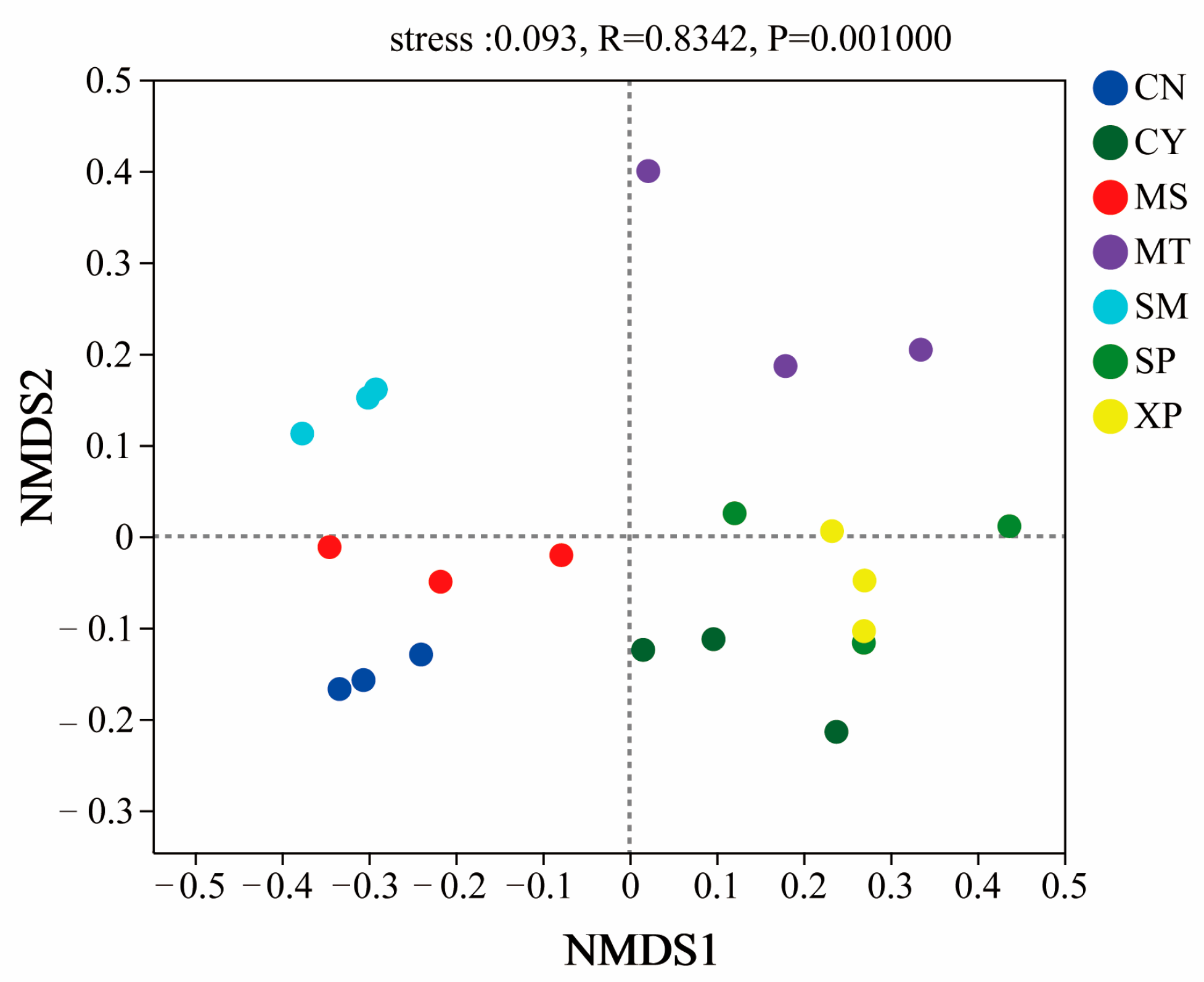
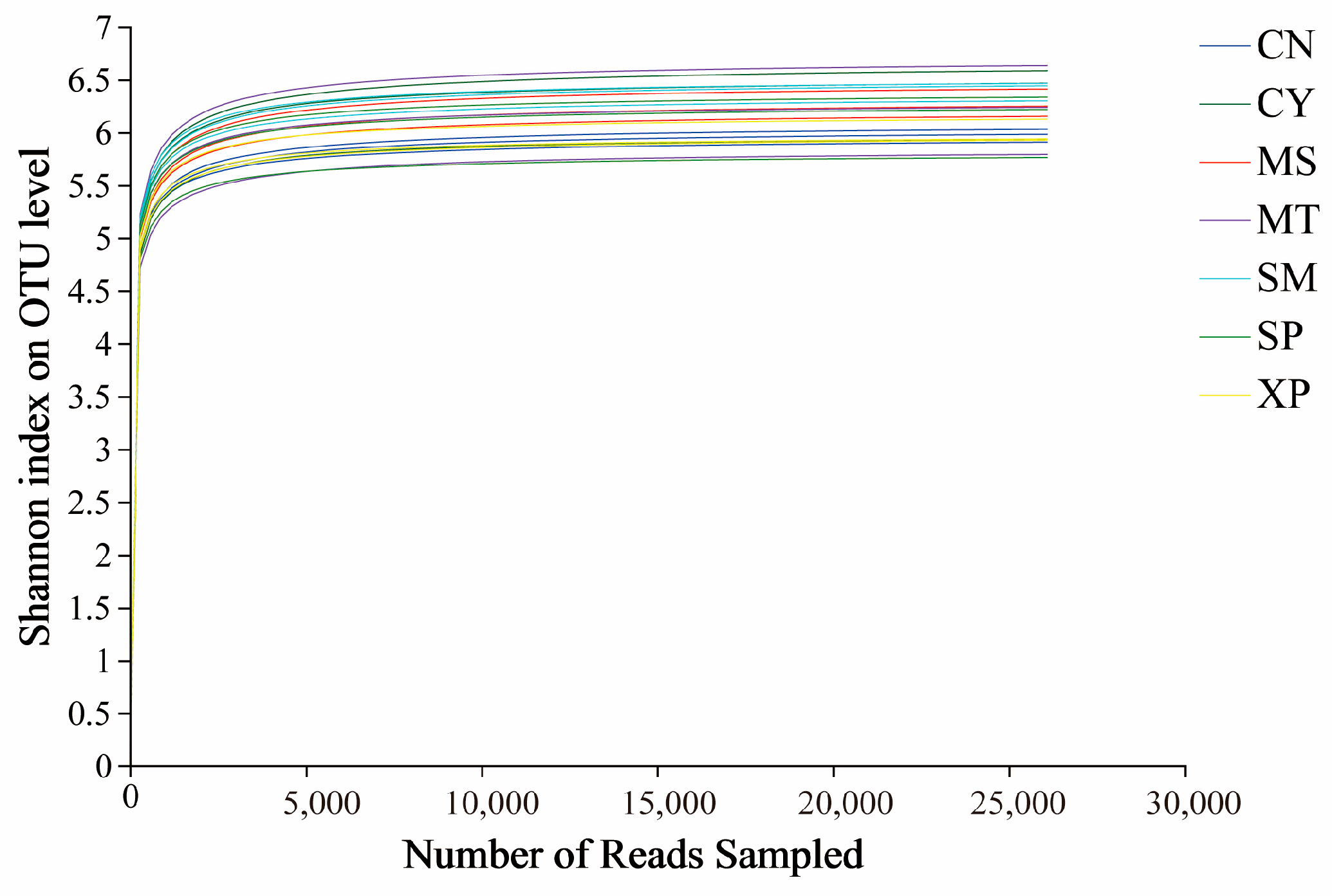
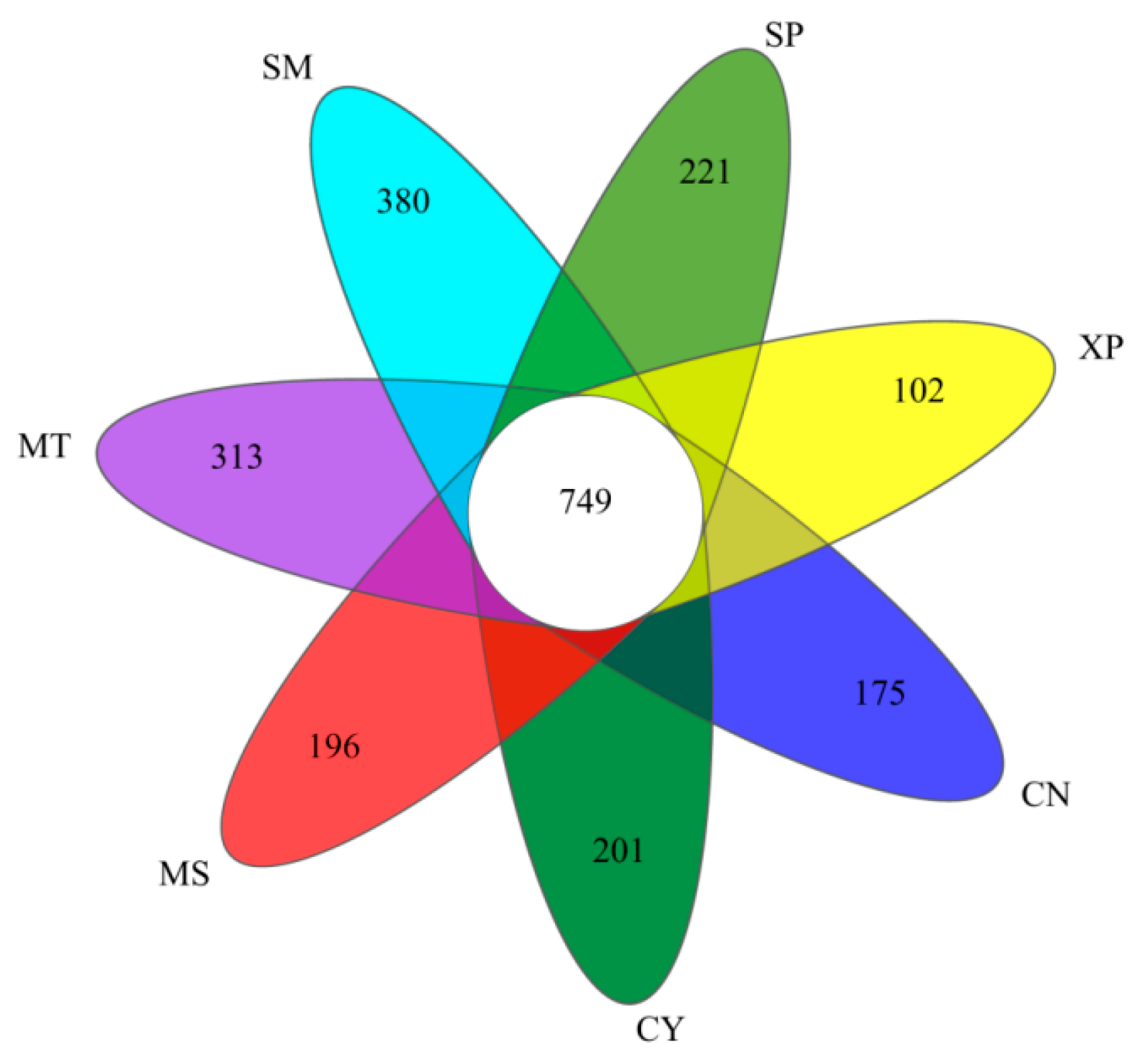
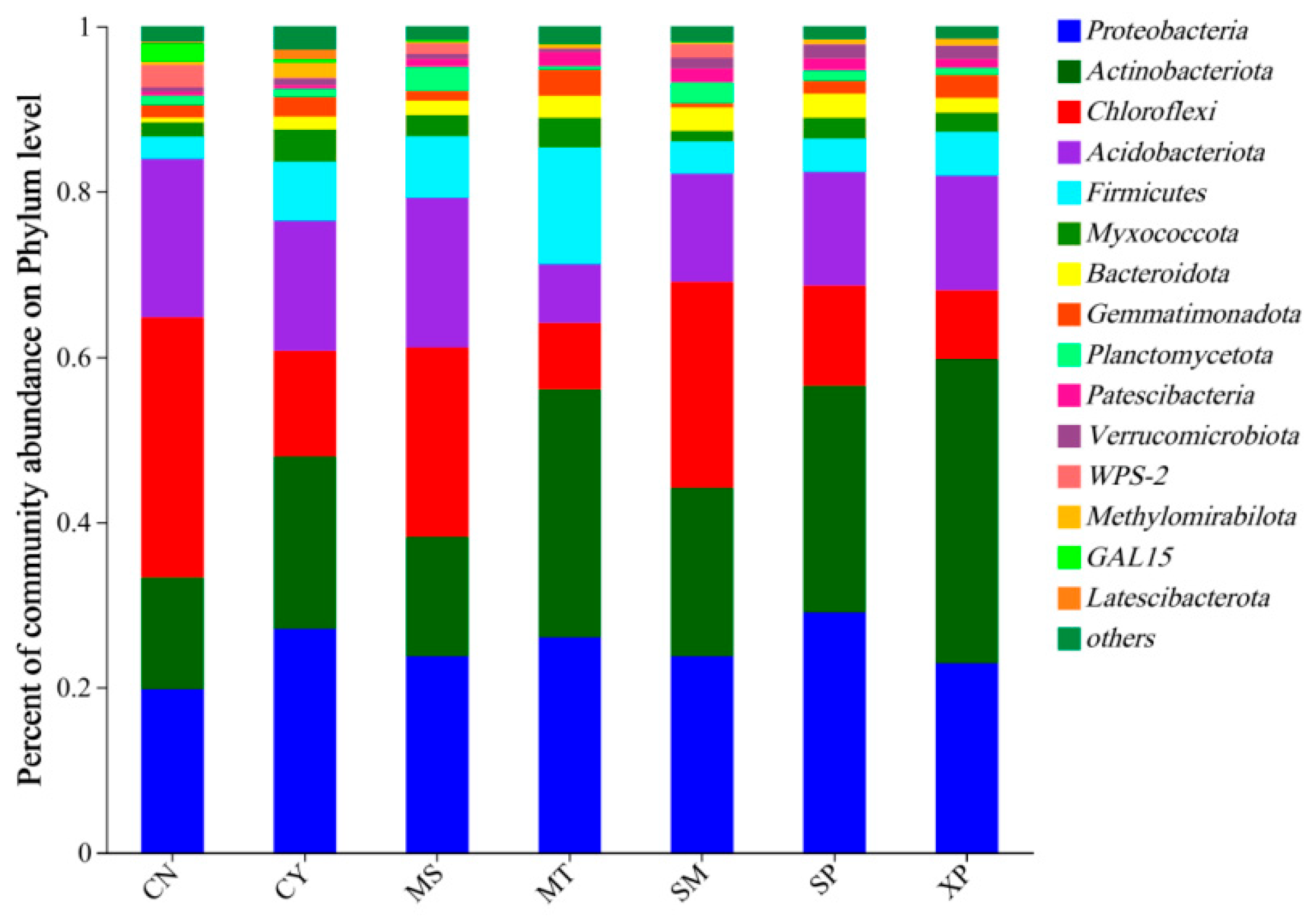
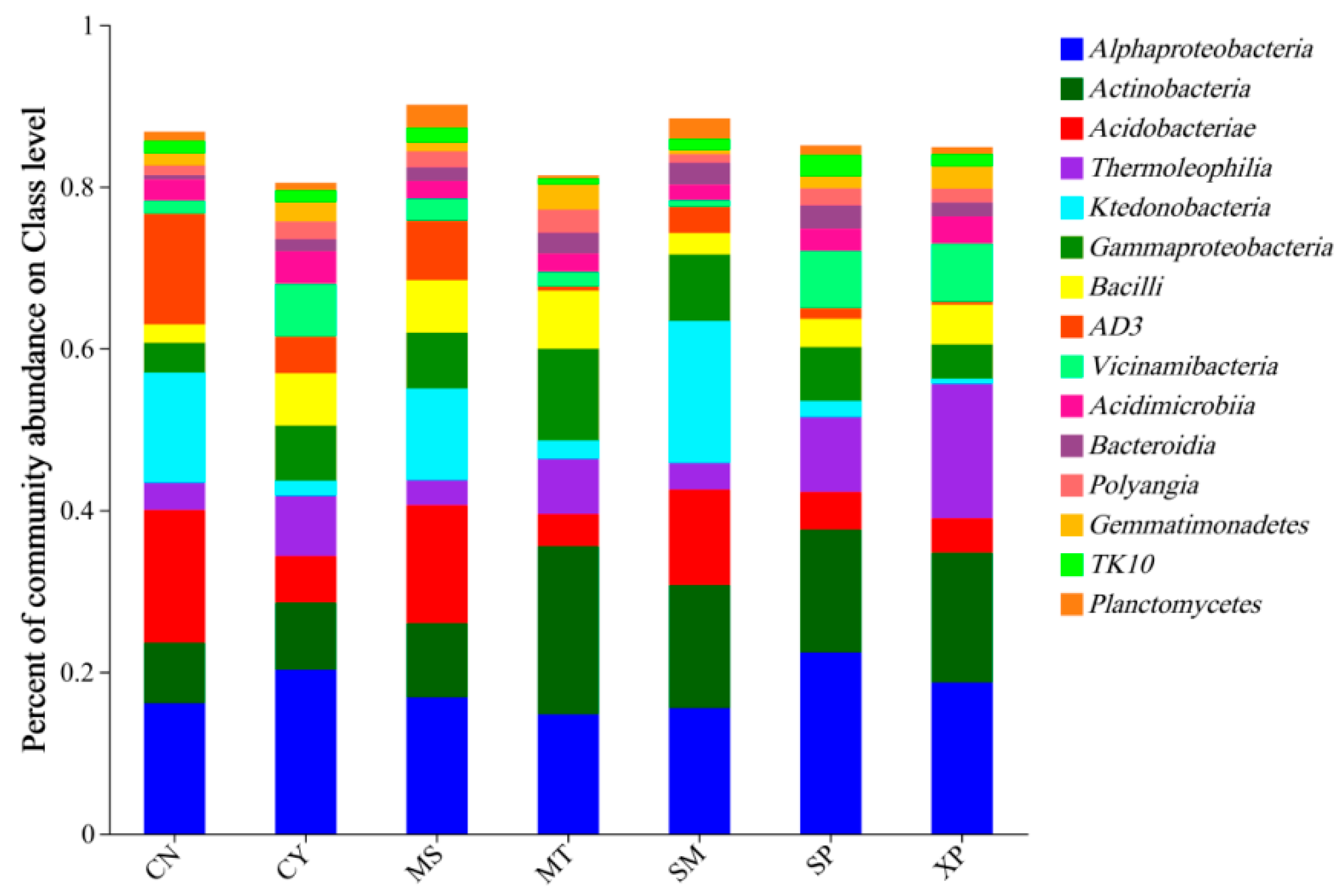
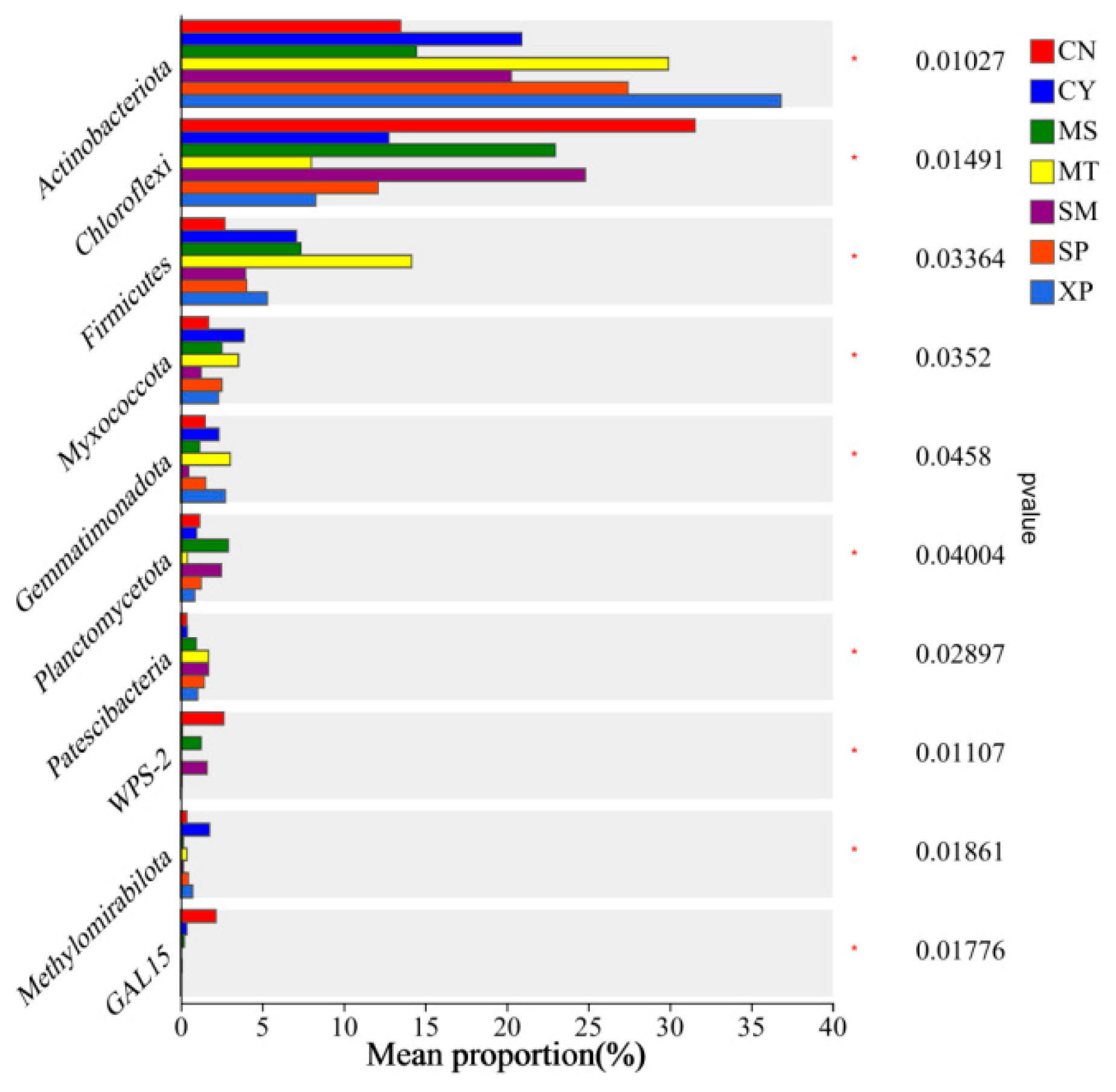
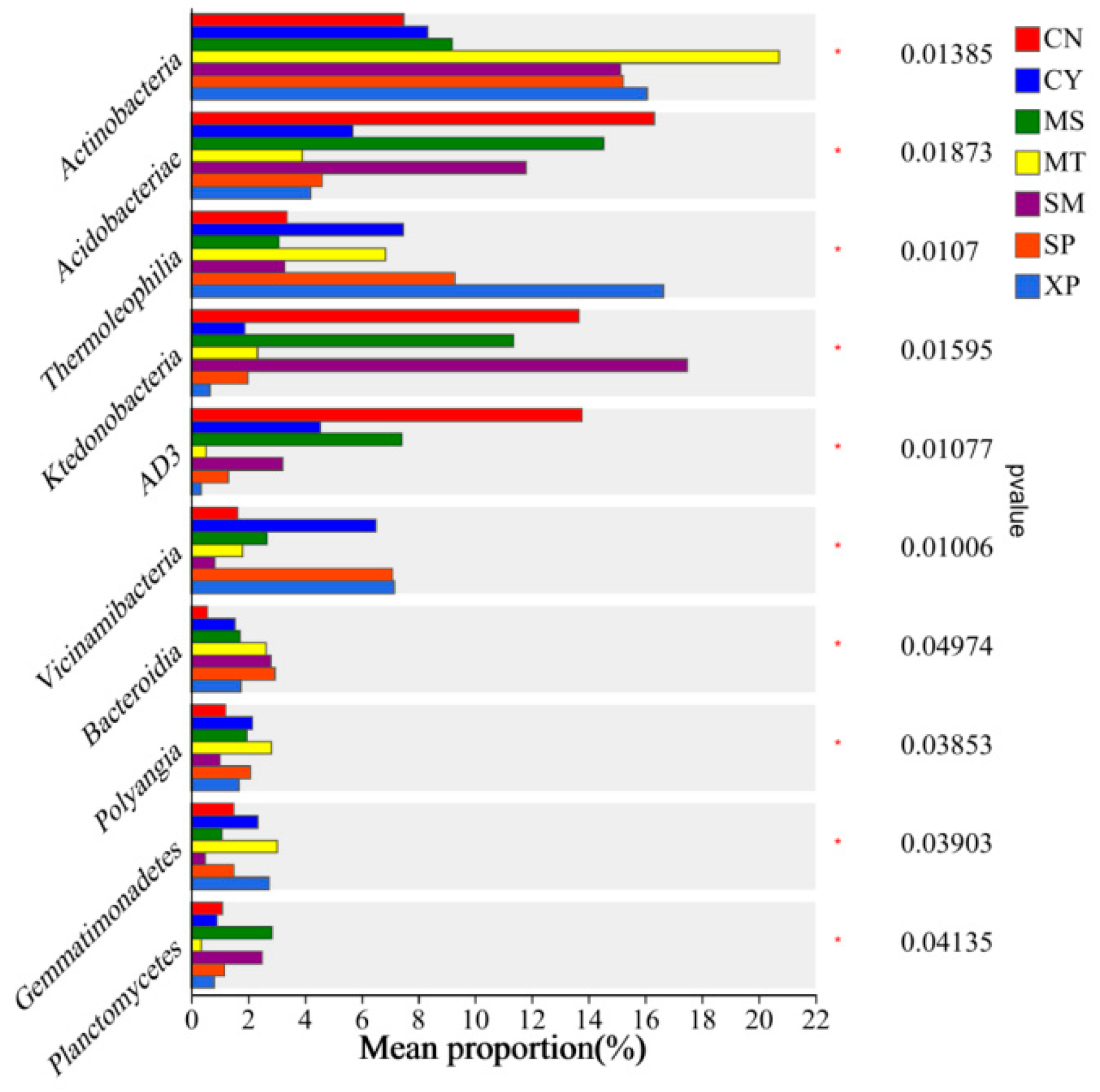

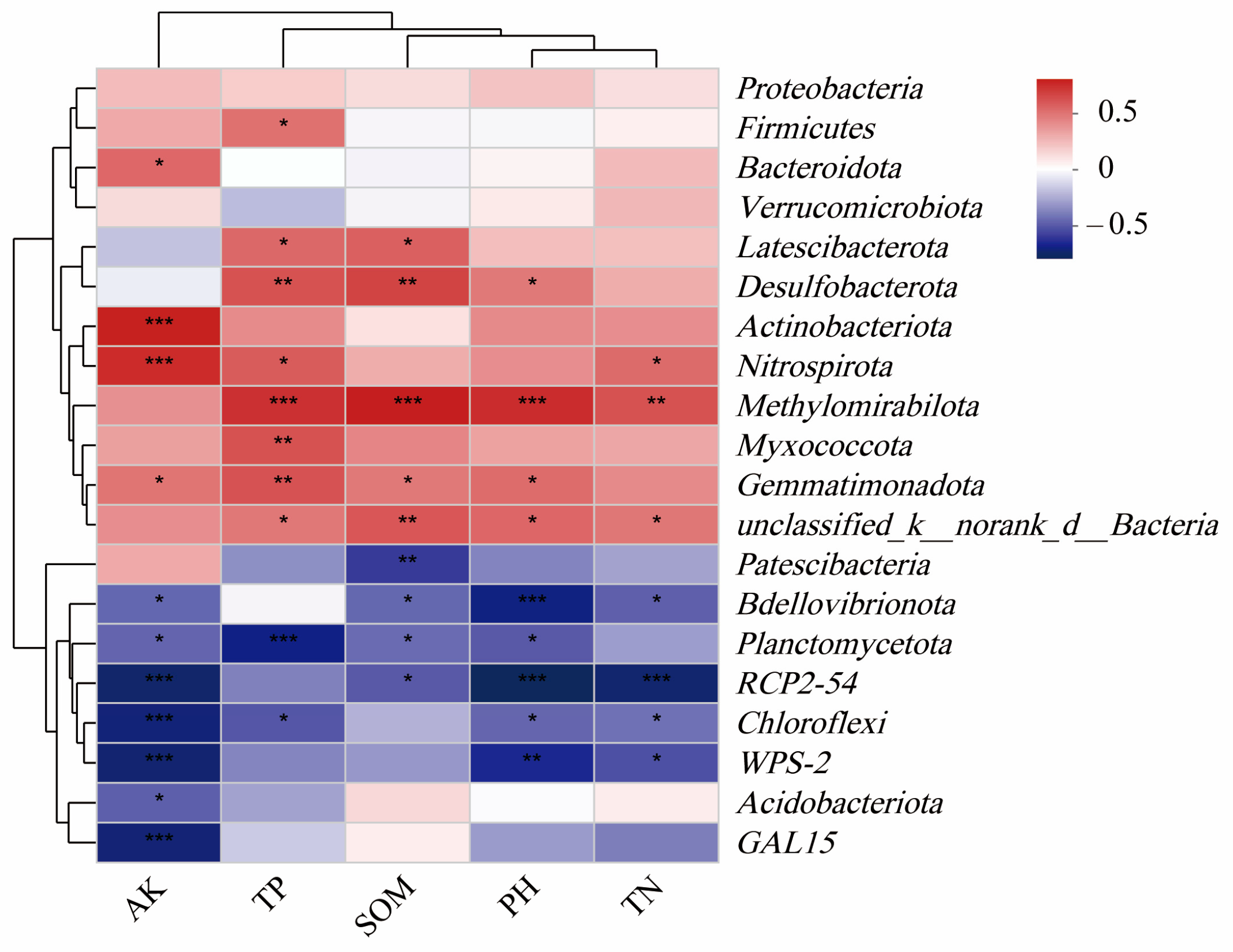

| Sampling Site | Longitude | Latitude | Altitude | Slope | Slope Orientation |
|---|---|---|---|---|---|
| MS | 98°23′17″ | 24°26′37″ | 1022 m | 13° | West slope |
| SP | 102°26′49″ | 23°44′22″ | 1457 m | 10° | Southwest slope |
| XP | 101°35′21″ | 24°0′28″ | 726 m | 11° | South slope |
| CN | 99°39′48″ | 24°31′32″ | 1229 m | 10° | West slope |
| MT | 100°16′35″ | 23°45′57″ | 1051 m | 15° | Southwest slope |
| SM | 101°8′5″ | 22°44′17″ | 1236 m | 17° | West slope |
| CY | 99°14′43″ | 23°11′47″ | 1425 m | 13° | Southwest slope |
| Regions | CN | MS | CY | MT | SM | SP | XP |
|---|---|---|---|---|---|---|---|
| pH | 5.13 ± 0.13 bc | 4.92 ± 0.15 bc | 5.56 ± 0.20 bc | 4.74 ± 0.01 cd | 4.33 ± 0.09 d | 6.50 ± 0.67 a | 5.80 ± 0.05 ab |
| SOM/g·kg−1 | 49.24 ± 4.47 ab | 32.08 ± 3.89 bc | 64.83 ± 8.99 a | 30.78 ± 1.49 bc | 23.64 ± 2.44 c | 43.19 ± 2.55 abc | 53.10 ± 16.26 ab |
| AP/mg·kg−1 | 14.43 ± 6.01 b | 3.24 ± 0.33 b | 5.88 ± 0.65 b | 57.85 ± 12.07 a | 13.80 ± 2.82 b | 3.67 ± 0.40 b | 5.71 ± 3.55 b |
| AK/mg·kg−1 | 59.58 ± 15.21 c | 68.33 ± 9.82 c | 205.83 ± 54.95 bc | 361.67 ± 127.33 ab | 172.50 ± 62.37 bc | 498.33 ± 60.85 a | 372.08 ± 74.74 ab |
| TN/g·kg−1 | 2.13 ± 0.55 ab | 1.76 ± 0.27 c | 3.41 ± 0.63 a | 1.79 ± 0.10 c | 1.78 ± 0.29 c | 2.75 ± 0.15 ab | 3.45 ± 0.74 a |
| TP/g·kg−1 | 0.56 ± 0.03 bc | 0.41 ± 0.02 bc | 0.90 ± 0.05 a | 0.97 ± 0.12 a | 0.38 ± 0.03 c | 0.46 ± 0.01 bc | 0.62 ± 0.12 b |
| TK/g·kg−1 | 10.09 ± 0.74 d | 19.09 ± 1.15 b | 17.59 ± 2.81 bc | 14.20 ± 0.54 cd | 21.99 ± 0.98 b | 5.67 ± 0.31 e | 28.96 ± 1.58 a |
| Phenotypes | CN | CY | MS | MT | SM | SP | XP |
|---|---|---|---|---|---|---|---|
| Aerobic ** | 83.27% | 73.71% | 82.72% | 59.18% | 72.98% | 67.70% | 58.40% |
| Anaerobic ** | 84.33% | 63.67% | 81.00% | 67.67% | 81.00% | 68.67% | 70.33% |
| Contains Mobile Elements ** | 73.19% | 67.58% | 77.25% | 80.69% | 81.39% | 74.24% | 75.27% |
| Facultatively Anaerobic * | 52.22% | 45.61% | 56.64% | 40.50% | 51.99% | 40.16% | 36.25% |
| Forms Biofilms ** | 16.73% | 26.29% | 17.28% | 40.82% | 27.02% | 32.30% | 41.60% |
| Gram Negative ** | 15.04% | 34.28% | 19.96% | 38.31% | 23.72% | 36.20% | 37.79% |
| Gram Positive | 6.72% | 7.45% | 8.19% | 7.45% | 8.23% | 9.61% | 8.16% |
| Potentially Pathogenic | 5.90% | 13.17% | 7.82% | 7.10% | 6.89% | 12.41% | 9.25% |
| Stress Tolerant ** | 3.10% | 8.61% | 3.55% | 5.02% | 1.68% | 9.04% | 9.54% |
Disclaimer/Publisher’s Note: The statements, opinions and data contained in all publications are solely those of the individual author(s) and contributor(s) and not of MDPI and/or the editor(s). MDPI and/or the editor(s) disclaim responsibility for any injury to people or property resulting from any ideas, methods, instructions or products referred to in the content. |
© 2024 by the authors. Licensee MDPI, Basel, Switzerland. This article is an open access article distributed under the terms and conditions of the Creative Commons Attribution (CC BY) license (https://creativecommons.org/licenses/by/4.0/).
Share and Cite
Chen, Q.; Zhang, M.; Omidvar, N.; Xu, Z.; Bai, S.H.; Hui, C.; Liu, W. Characteristic Analysis of the Soil Bacterial Community Structure of Dendrocalamus brandisii from Seven Geographical Provenances in Yunnan Province. Agronomy 2024, 14, 2010. https://doi.org/10.3390/agronomy14092010
Chen Q, Zhang M, Omidvar N, Xu Z, Bai SH, Hui C, Liu W. Characteristic Analysis of the Soil Bacterial Community Structure of Dendrocalamus brandisii from Seven Geographical Provenances in Yunnan Province. Agronomy. 2024; 14(9):2010. https://doi.org/10.3390/agronomy14092010
Chicago/Turabian StyleChen, Qian, Manyun Zhang, Negar Omidvar, Zhihong Xu, Shahla Hosseini Bai, Chaomao Hui, and Weiyi Liu. 2024. "Characteristic Analysis of the Soil Bacterial Community Structure of Dendrocalamus brandisii from Seven Geographical Provenances in Yunnan Province" Agronomy 14, no. 9: 2010. https://doi.org/10.3390/agronomy14092010






